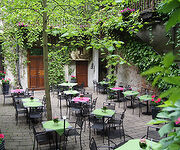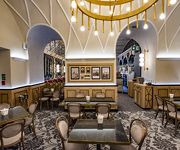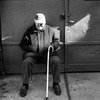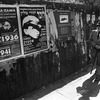Rules of the S.I.Witkiewicz Portrait-Painting Firm (1928)
Motto: The customer must be satisfied.
Misunderstandings are ruled out.
The rules are published so as to spare the firm the necessity of repeating the same thing over and over again.
1. The firm produces portraits of the following types:
1. Type A - Comparitively speaking, the most as it were, ' spruced up' type. Rather more suitable for women's faces than men's. 'Slick' execution, with a certain loss of character in the interests of beautification, or accentuation of 'prettiness'.
2. Type B - More emphasis on character but without any trace of caricature. Work making greater use of sharp line than type A, with a certain touch of character traits, which does not preclude 'prettiness' in women's portraits. Objective attitude to the model.
3. Type B + s (supplement) - Intensification of character, bordering on the caricatural. The head larger than natural size. The possibility of preserving 'prettiness' in women's portraits, and even of intensifying it in the direction of the 'demonic'.
4. Type C, C + Co, E, C + H, C + Co + E, etc. - These types, executed with the aid of CHO5 and narcotics of a superior grade, are at present ruled out. Subjective characterization of the model, caricatural intensification both formal and psychological are not ruled out. Approaches abstract composition, otherwise known as 'Pure Form'.
5. Type D - The same results without recourse to any artificial means.
6. Type E - Combinations of D with the preceding types. Spontaneous psychological interpretation at the discretion of the firm. The effect achieved may be the exact equivalent of that produced by types A and B - the manner by which it is attained different, as is the method of execution, which may take various forms but never exceeds the limit(s). A combination of E + s is likewise available on request.
Type E is not always possible ton execute.
7. Children's type - (B + E) - Because children can never stand still, the purer type B is in most instances impossible - the execution rather takes the form of a sketch.
In general, the firm does not pay much attention to the rendering of clothing and accessories. The question of the background concerns only the firm - demands in this regard are not considered. Depending on the disposition of the firm and the difficulties of rendering a particular face, the portrait may be executed in one, two, three, and even up to five sittings. For large portraits showing the upper boby or full figure, the number of sittings may even reach twenty.
The number of sittings does not determine the excellence of the product.
2. The basic novelty offered by the firm as compared to the usual practice is the customer's option of rejecting a portrait if it does not suit him either because of the execution or because of the degree of likeness. In such cases the customer pays one-third price, and the portrait becomes the property of the firm. The customer does not have the right to demand that the portrait be destoyed. This clause, naturally, applies only to the pure types: A, B, and E, without supplement (s) - that is, without any supplement of exaggereated characteristics, or in other words the types that appear in series. This clause was introduced because it is impossible to tell what will satify the client. An exact agreement is desirable, based upon a firm and definite decision by the model as to the type requested. An album of samples (but by no means ones 'of no value') is available for inspection at the premises of the firm. The customere receives a guarantee in that the firm in its own self-interest does not issue work that could damage its trademark. A situation could occur in which the firm itself would sign its own product.
3. Any sort of criticism on the part of the customer is absolutely ruled out. The customer may not like the portrait, but the firm cannot permit even the most discreet comments without giving its special authorization. If the firm had allowed itself the luxury of listening to customers' opinions, it would have gone mad a long time ago. We place special emphasis on this rule, since the most difficult thing is to refrain the customer from making remarks that are entirely uncalled for. The portrait is either accepted or rejected - yes or no, without any explanations whatsoever as to why. Inadmissable criticism likewise includes remarks about whether or not it is a good likeness, observations concerning the background, covering part of the face in the portrait with one hand so as to imply that this part really isn't the way it should be, comments such as, 'I am too pretty,' 'Do I look that sad?', 'That's not me," and all opinions of that sort, whether favourable or unfavourable. After due consideration, and possibly consultation with third parties, the customer says yes (or no) and that's all there is to it - then he goes (or does not go) up to what is called the 'cashier's window', that is, he simply hands over the agreed-upon sum to the firm. Given the incredible difficulty of the profession, the firm's nerves must be spared.
4. Asking the firm for its opinion of a finished portrait is not permissable, nor is any discussion about a work in progress.
5. The firm reserves the right to paint without any witnesses, if that is possible.
6. Portraits of women with bare necks and shoulders cost one-third more. Each arm costs one third of the total price. For portraits showing the upper body or full figure, special agreements must be drawn up.
7. The portrait may not be viewed until finished.
8. The technique used is a combination of charcoal, crayon, pencil and pastel. All remarks with regard to technical matters are ruled out, as are demands for alterations.
9. The firm undertakes the painting of portraits outside the firm's premises only in exceptional circumstances (sickness, advanced age, etc.) in which case the firm must be guaranteed a secret receptacle in which the unfinished work may be kept under lock and key.
10. Customers are obliged to appear punctually for sittings, since waiting has a bad effect on the firm's mood and may have an adverse effect on the execution of the product.
11. The firm offers advice on framing and packing of portraits but does not provide these services. further discussion about types of frames is ruled out.
12. The firm allows total freedom as to the model's clothing and quite definitely does not voice any opinion in this regard.
13. the firm encourages a careful perusal of the rules. Lacking any powers of enforcement, the firm counts on the tact and good will of its customers to meet the terms. Reading through and concurring with the rules is taken as equivalent to concluding an agreement. Discussion about the rules is inadmissible.
14. An agreement on the instalment plan or by bank draft is not ruled out. given the low prices the firm charges, requests for reductions are not advisable. Before the portrait is begun, the customer pays one third of the price as a down payment.
15. A custmer who obtains portrait commissions for the firm - that is to say, who acts as 'an agent of the firm' - upon providing orders for the sum of 100 zlotys receives as a premium his own portrait or that of any person he wishes in the type of his choice.
16. Notices sent by the firm to former customers announcing its presence at a given location are not intended to force them to have new portraits painted, but rather to assist friends of these customers in placing orders, since having seen the firm's work they may wish something similar themselves.
WARSAW, 1928
THE 'S.I.WITKIEWICZ' FIRM
(To find out more about the adventures of Stanislas Ignacy Witkiewicz, track down D. Gerould's meticulously researched ' The Witkiewicz Reader', Illinois, 1992, or click on the link below)

 Kawaleria Szarza Smaku
Kawaleria Szarza Smaku
 Europejska
Europejska
 Krakow Pinball Museum
Krakow Pinball Museum






